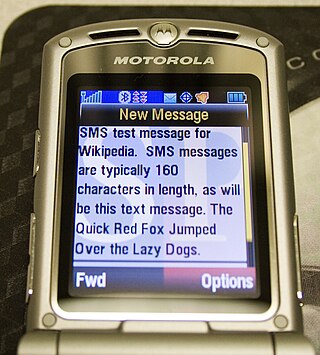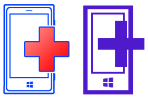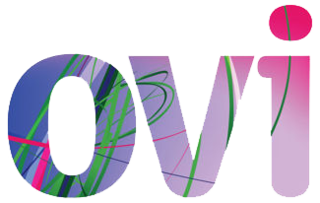
Short Message Service, commonly abbreviated as SMS, is a text messaging service component of most telephone, Internet and mobile device systems. It uses standardized communication protocols that let mobile devices exchange short text messages. An intermediary service can facilitate a text-to-voice conversion to be sent to landlines.

The Nokia 6230 is a mobile phone based on the Nokia Series 40 platform. It was announced on 28 October 2003 and released in February 2004.

The Nokia 9210 Communicator is a third-generation Communicator series mobile phone produced by Nokia, announced on 21 November 2000 and released in June 2001. It greatly improved on the second generation Nokia 9110 Communicator, providing a colour main screen and using an ARM processor. It is one of the few mobile phones able to send and receive fax.
The Nokia 3310 is a discontinued GSM mobile phone announced on 1 September 2000, and released in the fourth quarter of the year, replacing the popular Nokia 3210. It sold very well, being one of the most successful phones, with 126 million units sold worldwide, and being one of Nokia's most iconic devices. The phone is still widely acclaimed and has gained a cult status due to its reputation for durability.

The Nokia 9000 Communicator was the first product in Nokia's Communicator series, announced at CeBIT 1996 and introduced into the market on 15 August 1996. The phone weighed 397 grams (14.0 oz), was powered by an Intel 24 MHz i386 CPU, and had 8 MB of memory. The memory was divided between applications (4 MB), program memory (2 MB) and user data (2 MB). The operating system was PEN/GEOS 3.0. The Communicator was one of the earliest smartphones on the market, after the IBM Simon in 1994 and the HP OmniGo 700LX, a DOS-based palmtop PC with integrated cradle for the Nokia 2110 cellular mobile phone, announced in late 1995 and shipped in March 1996.

Nokia 8210 is a mobile phone by Nokia, announced on 8 October 1999 in Paris. At the time, it was the smallest, lightest Nokia mobile phone on the market. A primary selling point of its design was its removable cover that allowed for easy customization. Six differently coloured Xpress-on covers are available, as well as many third-party ones.

Nokia PC Suite is a discontinued software package used to establish an interface between Nokia mobile devices and computers that run the Microsoft Windows operating system. Its first release was in 1997, originally called Nokia Data Suite. It was replaced by Nokia Suite and integrated into the Ovi service suite.

The Nokia 8850 is a mobile phone handset manufactured by Nokia. It was a light alloy-bodied enhanced version of Nokia 8210 model with slider protection of the keypad and white lighting of the keypad and screen. The 8850 is considered to be an un-repairable phone, thus resulting in very few active handsets in the market. Today it remains a collector's item. It also came in gold. It was introduced as a successor of an earlier model, the chrome phone Nokia 8810.

Microsoft Software Updater is a Windows and OS X based application launched in 2006, that enables customers to update and recover their mobile device firmware of a S40 or S60 or Lumia device from any Internet enabled access point. To avoid data loss users are prompted with on-screen advice on how to safely update their device.

Sanomalaite M/90 (SANLA) is a digital, portable and encrypted text-based communications device developed by Nokia and used by all branches of Finnish Defence Forces.

Ovi by Nokia was the brand for Nokia's Internet services. The Ovi services could be used from a mobile device, computer or via the web. Nokia focused on five key service areas: Games, Maps, Media, Messaging and Music. Nokia's aim with Ovi was to include third party developers, such as operators and third-party services like Yahoo's Flickr photo site. With the announcement of Ovi Maps Player API, Nokia started to evolve their services into a platform, enabling third parties to make use of Nokia's Ovi services.

Nokia 5300 XpressMusic is a slider mobile phone by Nokia, part of the XpressMusic range. It was introduced on 26 September 2006 and released at the end of that year. It runs on Nokia Series 40 3rd Edition FP2.

MSN Messenger, later rebranded as Windows Live Messenger, was a cross-platform instant-messaging client developed by Microsoft. It connected to the now-discontinued Microsoft Messenger service and, in later versions, was compatible with Yahoo! Messenger and Facebook Messenger. The service was discontinued in 2013 and was replaced by Skype.
The Nokia 6301 is a triband GSM mobile phone approved by the FCC for the US market in January 2008. It has two major models; the 6301b RM-323 for the North American market and the 6301 RM-322 for the European market. Model 6301b is equipped with 850/1800/1900 MHz bands and model 6301 is equipped with 900/1800/1900 MHz bands.
Mobile security, or mobile device security, is the protection of smartphones, tablets, and laptops from threats associated with wireless computing. It has become increasingly important in mobile computing. The security of personal and business information now stored on smartphones is of particular concern.

The Nokia Asha 303 is a QWERTY messenger smartphone powered by Nokia's Series 40 operating system. It was announced at Nokia World 2011 in London along with three others Asha phones - the Nokia Asha 200, 201 and 300. The 303 is considered to be the flagship of the Asha family. Its main features are the QWERTY keyboard and capacitive touchscreen, the pentaband 3G radio, SIP VoIP over 3G and Wi-Fi and the ability to play Angry Birds which were all never seen before on a Series 40 phone. Nokia Asha 303 is available in a number of languages depending on which territory it is marketed for. Models sold in South Asia support at least eight languages: English, Hindi, Gujarati, Marathi, Tamil, Kannada, Telugu and Malayalam.
The Nokia 8810 is a discontinued slider-style mobile phone announced and manufactured by Nokia in 1998. It is notable for being among the first mainstream mobile devices to have an internal antenna, although the first is regarded as the TCP-6000, released as the Hagenuk GlobalHandy.

The Nokia Asha 302 is a QWERTY messenger feature phone powered by Nokia's Series 40 operating system. It was announced at Mobile World Congress 2012 in Barcelona along with other Asha phones - the Nokia Asha 202 and 203. The 302 is considered to be among the flagship of the Asha family. Its main features are the QWERTY keyboard, the pentaband 3G radio, SIP VoIP over 3G and Wi-Fi. Its design looks a lot like the older Nokia E6 with chrome slidings, giving it a somewhat premium look. A software update adds Mail for Exchange support.

Nokia C1-02 is a basic phone running on Nokia OS Series 40, announced in June 2010 and released in January 2011. It supports two battery types, Nokia BL-5C and BL-5CB. It has an internal memory of 10MB and RAM of 16MB. The expandable memory of the device is up to 32GB. It is available in 4 colours namely - Black, Dark Plum, Blue and Cool Grey. Its cost in July 2015 was around Rs. 2169 in India. Outside India it was sold at $19.99 approx.














